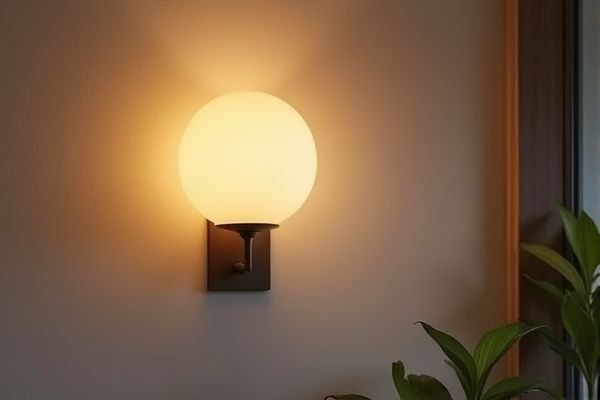
Wall sconces provide focused, ambient lighting ideal for accentuating specific areas, while ceiling fixtures offer broader, general illumination for entire rooms. Discover which lighting option suits Your space best by reading the full comparison in the rest of the article.
Table of Comparison
| Feature | Wall Sconce | Ceiling Fixture |
|---|---|---|
| Installation Location | Mounted on walls | Mounted on ceiling |
| Lighting Type | Ambient, accent, task lighting | Ambient, general lighting |
| Space Saving | Yes, frees floor and surface space | Yes, utilizes ceiling space |
| Design Style | Decorative, accent pieces | Functional and decorative |
| Maintenance | Accessible, easier to clean | Harder to reach for cleaning/replacement |
| Lighting Coverage | Directional, localized | Wide area coverage |
| Electrical Requirements | Wired to wall circuit | Wired to ceiling circuit |
| Common Rooms | Hallways, living rooms, bedrooms | Living rooms, kitchens, bathrooms |
Introduction: Wall Sconce vs Ceiling Fixture
Wall sconces and ceiling fixtures both provide essential lighting but serve different design purposes and spatial needs. Wall sconces offer focused, ambient lighting and enhance decor by creating accentuated wall features, while ceiling fixtures provide broader illumination suitable for overall room brightness. Choosing between them depends on room size, lighting requirements, and aesthetic preferences.
Design and Aesthetic Differences
Wall sconces create focused accent lighting that highlights architectural features or artwork, adding depth and visual interest to your space, while ceiling fixtures provide broader, ambient illumination that evenly lights an entire room. The design of wall sconces often incorporates decorative elements and can serve as statement pieces on bare walls, whereas ceiling fixtures typically have a more centralized and functional design with various styles ranging from chandeliers to flush mounts. Choosing between a wall sconce and a ceiling fixture influences the room's atmosphere and style, allowing you to customize lighting to fit specific aesthetic goals and enhance interior decor.
Light Distribution and Coverage
Wall sconces provide focused, ambient lighting ideal for accentuating specific areas or creating mood lighting with limited coverage, while ceiling fixtures offer broader, more uniform light distribution that effectively illuminates entire rooms. Your choice depends on the lighting needs: use wall sconces for localized, decorative illumination and ceiling fixtures for comprehensive, general lighting coverage. The combination of both can enhance layered lighting design, balancing task and ambient light.
Installation and Placement Options
Wall sconces offer versatile installation options, typically mounted at eye level on walls to provide ambient or accent lighting while saving ceiling space. Ceiling fixtures are installed on the ceiling, making them ideal for general illumination across larger areas but requiring electrical wiring overhead. Your choice depends on room layout and lighting needs, as wall sconces enhance specific zones and ceiling fixtures ensure broad, even light coverage.
Space-Saving Considerations
Wall sconces are ideal for space-saving in small rooms as they mount directly on walls, freeing up valuable floor and ceiling areas. Ceiling fixtures require overhead space and may limit room height options, making them less suitable for low ceilings. Choosing wall sconces enhances room openness and allows flexible furniture arrangement by preserving both floor and ceiling space.
Energy Efficiency and Bulb Types
Wall sconces often use lower wattage bulbs such as LEDs or CFLs, making them more energy-efficient for ambient or accent lighting compared to ceiling fixtures that typically require higher wattage bulbs to illuminate larger spaces. Ceiling fixtures offer a wider variety of bulb types, including incandescent, halogen, and smart bulbs, allowing customization of brightness and color temperature to suit your needs. Choosing a wall sconce with LED bulbs can reduce energy consumption and lower utility bills while maintaining effective lighting in specific areas of your home.
Maintenance and Cleaning
Wall sconces typically require less maintenance and are easier to clean due to their placement at eye level, allowing You to quickly access and dust them without special equipment. Ceiling fixtures often accumulate more dust and cobwebs, especially recessed or chandelier types, necessitating regular deep cleaning and sometimes the use of ladders or extension tools. Choosing a lighting option with removable shades or covers can further simplify cleaning tasks and enhance durability.
Cost Comparison and Budget Tips
Wall sconces typically cost less than ceiling fixtures, with prices ranging from $50 to $200 compared to $100 to $500 for ceiling lights, making them budget-friendly options for accent lighting. Installation costs for wall sconces can be lower if you have existing wiring, but may increase if new electrical work is required. To manage your budget effectively, consider energy-efficient LED bulbs and opt for simpler designs to reduce both upfront costs and energy expenses over time.
Best Applications for Each Fixture
Wall sconces are ideal for creating ambient or accent lighting in hallways, bathrooms, and bedrooms where space is limited and targeted illumination enhances decor. Ceiling fixtures work best in rooms requiring broad, general lighting such as kitchens, living rooms, and dining areas, providing uniform light distribution. Your choice depends on whether you need decorative, space-saving lighting or comprehensive room illumination.
Choosing the Right Fixture for Your Space
Wall sconces provide targeted, ambient lighting ideal for hallways, accent walls, or small spaces, enhancing decor while saving floor space. Ceiling fixtures deliver broad, even illumination, making them optimal for general lighting in larger rooms like living rooms or kitchens. Assessing room size, lighting needs, and design goals ensures selecting the right fixture improves both functionality and aesthetic appeal.
 homyna.com
homyna.com